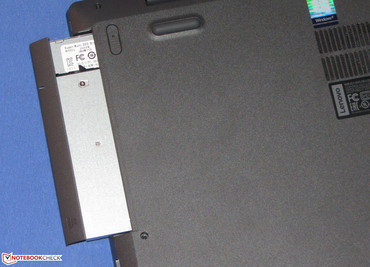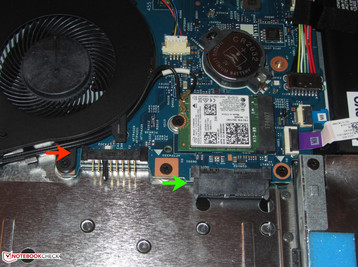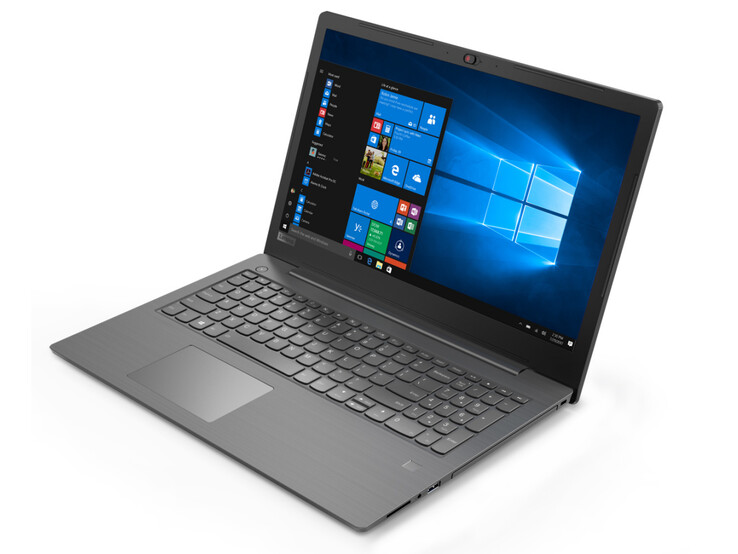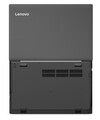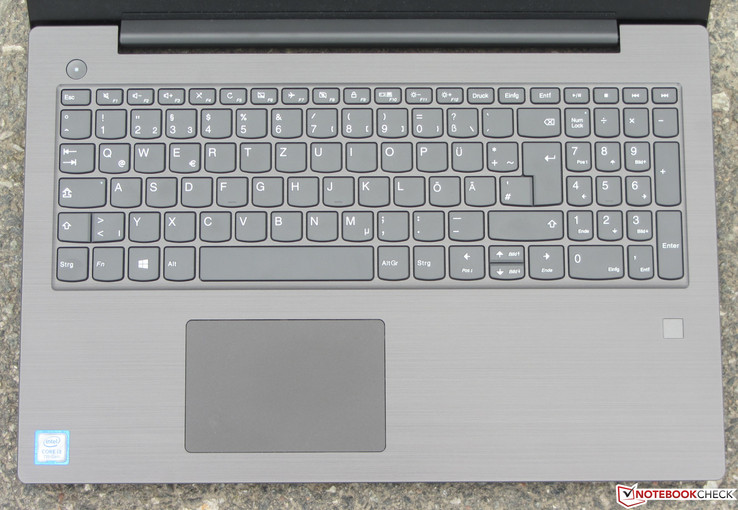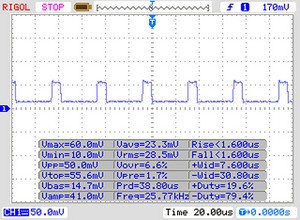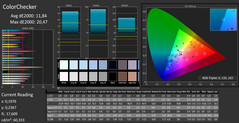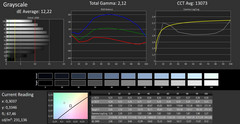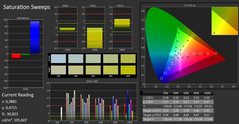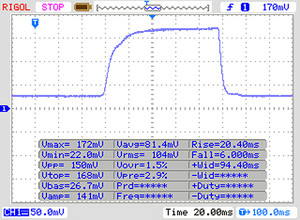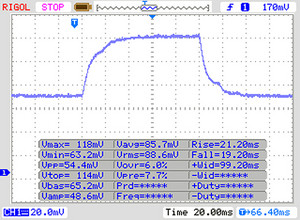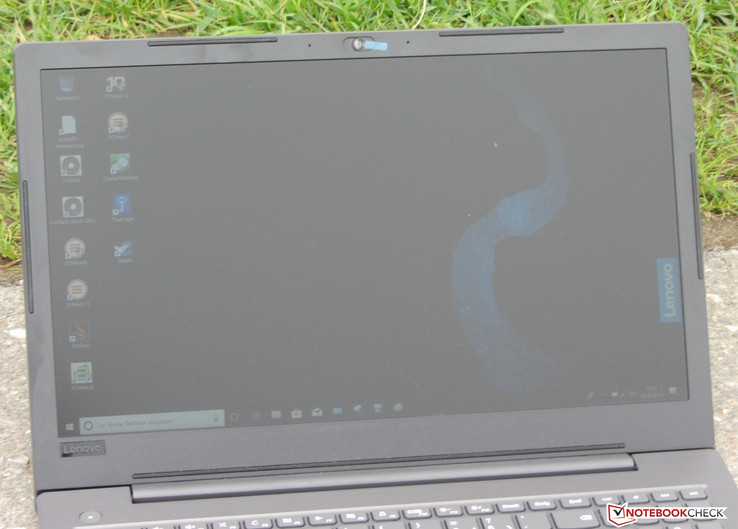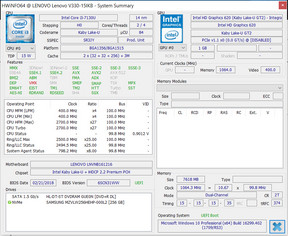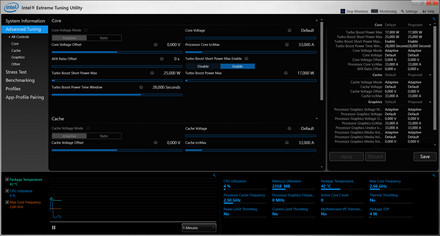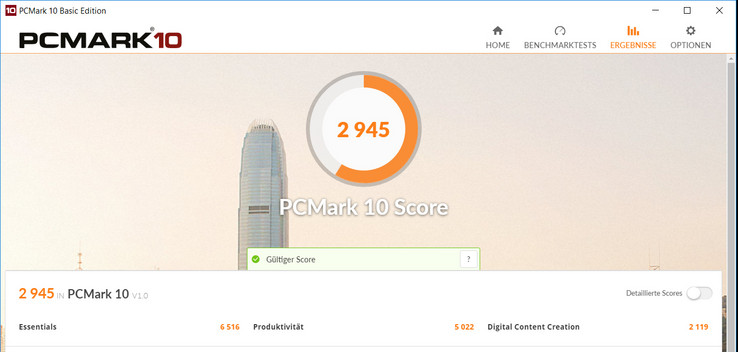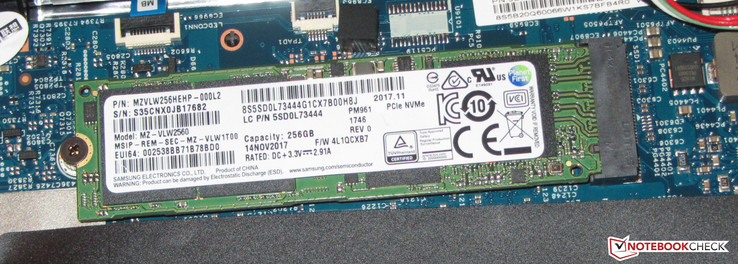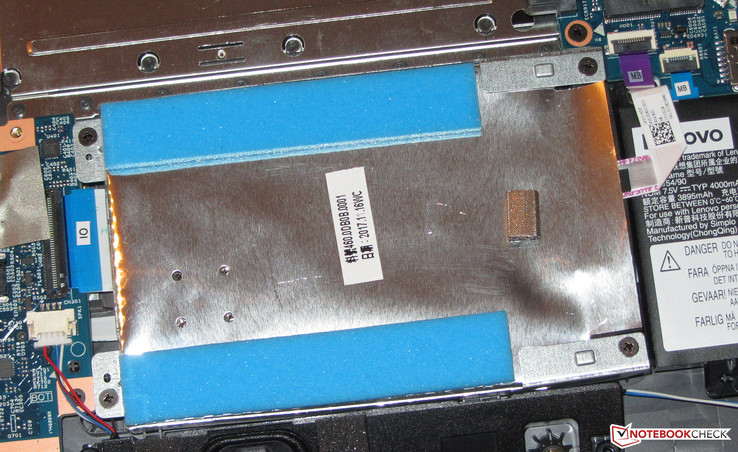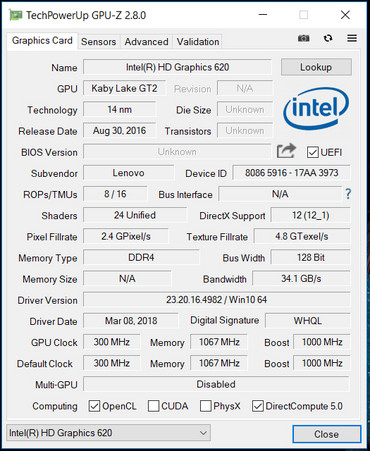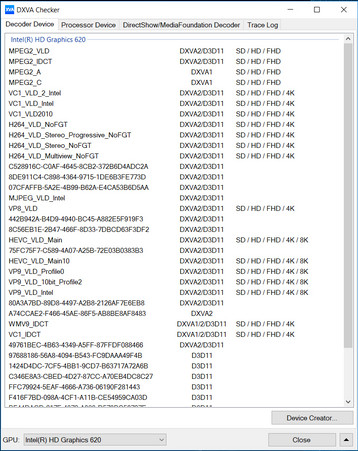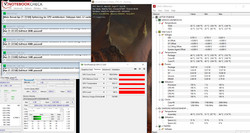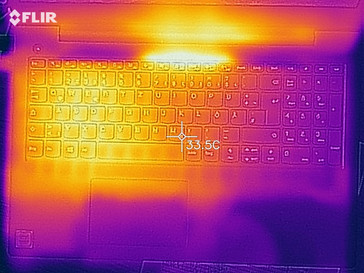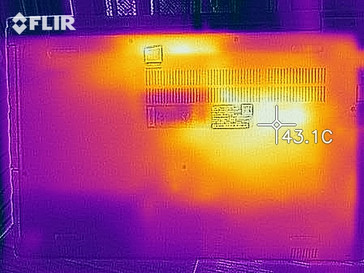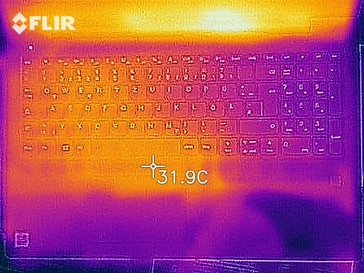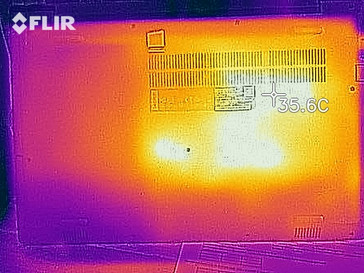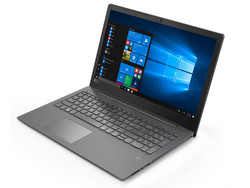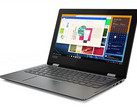Lenovo V330-15IKB (i3-7130U, SSD, FHD) Laptop Review

The Lenovo V330-15IKB is a 15.6-inch office notebook. It is intended for both private and professional users. The laptop is powered by a Kaby Lake Core i3 processor. The competing devices include: The Acer TravelMate P2510-M, the Dell Vostro 15 3568 and the HP 250 G6.
Case & Connectivity - Lenovo uses a plastic case
The plastic case of the Lenovo notebook comes in the color scheme "Iron Gray". The upper side of the chassis and the display lid are adorned with a textured pattern that simulates brushed metal. The build quality is in good order. However, the chassis could have been somewhat more rigid: It can be twisted or bent with little force. The laptop does not offer a maintenance hatch. In order to reach the internals, you will have to remove the entire bottom cover.
The optical disk drive of the V330-15IKB can be removed without any tools. To do this, you will have to pull up the slider on the underside of the device. The optical disk drive can be removed after that. Why does Lenovo use such a mechanism? The optical drive slot is intended not only for an optical disk drive but also for a secondary battery. The user manual mentions this battery specifically. Our review device features an appropriate connector for a secondary battery. Nevertheless, at this moment, it is unclear whether such a battery will be available in Germany. At the time of this review, we could not find this battery in either one of the established online stores or in Lenovo’s store.
The laptop offers plenty of ports. All in all, the Lenovo V330-15IKB features four USB 3.1 Gen 1 ports (two Type-A ports, two Type-C ports). The device can be charged via one of the two USB Type-C ports. There are two ports for video-output (VGA, HDMI).
The SD card reader offers mediocre speeds. When copying large chunks of data, a transfer rate of 26.3 MB/s was achieved. When copying 250 JPG image files (each approximately 5 MB in size), we observed an average speed of 21.1 MB/s. We test the SD card reader with the help of a reference SD card (Toshiba Exceria Pro SDXC 64 GB UHS-II).
The Wi-Fi module comes from Intel (Dual Band Wireless-AC 8265). Besides the Wi-Fi standards 802.11 a/b/g/n, it also supports the fast AC standard. The data transfer speeds that we measured under the optimal conditions (no other Wi-Fi-enabled devices in close proximity, a short distance between the notebook and the server PC) are quite average.
Ports
| SD Card Reader | |
| average JPG Copy Test (av. of 3 runs) | |
| Average of class Office (22.4 - 198.5, n=28, last 2 years) | |
| Acer TravelMate P2510-M-51ZQ (Toshiba Exceria Pro SDXC 64 GB UHS-II) | |
| HP 250 G6 2UB93ES (Toshiba Exceria Pro SDXC 64 GB UHS-II) | |
| Dell Vostro 15 3568 (Toshiba Exceria Pro SDXC 64 GB UHS-II) | |
| Lenovo V330-15IKB (Toshiba Exceria Pro SDXC 64 GB UHS-II) | |
| maximum AS SSD Seq Read Test (1GB) | |
| Average of class Office (25 - 249, n=26, last 2 years) | |
| HP 250 G6 2UB93ES (Toshiba Exceria Pro SDXC 64 GB UHS-II) | |
| Acer TravelMate P2510-M-51ZQ (Toshiba Exceria Pro SDXC 64 GB UHS-II) | |
| Lenovo V330-15IKB (Toshiba Exceria Pro SDXC 64 GB UHS-II) | |
| Dell Vostro 15 3568 (Toshiba Exceria Pro SDXC 64 GB UHS-II) | |
| Networking | |
| iperf3 transmit AX12 | |
| Acer TravelMate P2510-M-51ZQ | |
| HP 250 G6 2UB93ES | |
| Dell Vostro 15 3568 | |
| Lenovo V330-15IKB | |
| iperf3 receive AX12 | |
| Acer TravelMate P2510-M-51ZQ | |
| Dell Vostro 15 3568 | |
| Lenovo V330-15IKB | |
| HP 250 G6 2UB93ES | |
Input Devices - The V330-15IKB does not offer a keyboard backlight
Lenovo has equipped the V330-15IKB with an unlit chiclet-style keyboard. A numeric pad is provided. The flat, slightly rough keys have a short travel distance and a clear actuation point. We are pleased with the resistance of the keys. During typing, the keyboard exhibits some flex. However, this does not prove to be annoying. All in all, Lenovo delivers a good keyboard here, although a keyboard backlight is missed.
The multitouch-enabled ClickPad takes up an area of some 10.5 x 7.3 cm (4.1 x 2.9 in). Therefore, it offers enough space for gesture controls. The various gestures can be enabled or disabled in the configurations menu of the pad. The smooth surface of the pad makes finger-gliding easy. The ClickPad has a short travel distance and a clear actuation point.
Display - The screen of the Lenovo laptop fails to inspire enthusiasm
The matte 15.6-inch display of the V330-15IKB operates with a native resolution of 1920x1080. The brightness (199.8 cd/m²) and the contrast ratio (511:1) are too low.
The display evinces PWM flickering at all brightness levels. It flickers with a frequency of 25000 Hz. Because of such a high frequency, even susceptible individuals should not experience any adverse effects like headaches and eyestrain.
| |||||||||||||||||||||||||
Brightness Distribution: 77 %
Center on Battery: 230 cd/m²
Contrast: 511:1 (Black: 0.45 cd/m²)
ΔE ColorChecker Calman: 11.84 | ∀{0.5-29.43 Ø4.78}
ΔE Greyscale Calman: 12.22 | ∀{0.09-98 Ø5}
59% sRGB (Argyll 1.6.3 3D)
38% AdobeRGB 1998 (Argyll 1.6.3 3D)
40.65% AdobeRGB 1998 (Argyll 3D)
58.8% sRGB (Argyll 3D)
39.32% Display P3 (Argyll 3D)
Gamma: 2.12
CCT: 13073 K
| Lenovo V330-15IKB TN LED, 1920x1080, 15.6" | HP 250 G6 2UB93ES TN LED, 1920x1080, 15.6" | Acer TravelMate P2510-M-51ZQ IPS, 1920x1080, 15.6" | Dell Vostro 15 3568 TN LED, 1920x1080, 15.6" | |
|---|---|---|---|---|
| Display | -1% | 8% | 0% | |
| Display P3 Coverage (%) | 39.32 | 39.11 -1% | 42.44 8% | 39.39 0% |
| sRGB Coverage (%) | 58.8 | 58.8 0% | 63.2 7% | 59.3 1% |
| AdobeRGB 1998 Coverage (%) | 40.65 | 40.41 -1% | 43.94 8% | 40.69 0% |
| Response Times | 23% | -18% | 30% | |
| Response Time Grey 50% / Grey 80% * (ms) | 40 ? | 42 ? -5% | 45 ? -13% | 39 ? 2% |
| Response Time Black / White * (ms) | 26 ? | 13 ? 50% | 32 ? -23% | 11 ? 58% |
| PWM Frequency (Hz) | 25000 | 2500 ? | 25000 ? | 28410 ? |
| Screen | -1% | 24% | -3% | |
| Brightness middle (cd/m²) | 230 | 184 -20% | 215 -7% | 195 -15% |
| Brightness (cd/m²) | 200 | 178 -11% | 198 -1% | 195 -2% |
| Brightness Distribution (%) | 77 | 80 4% | 78 1% | 89 16% |
| Black Level * (cd/m²) | 0.45 | 0.38 16% | 0.32 29% | 0.44 2% |
| Contrast (:1) | 511 | 484 -5% | 672 32% | 443 -13% |
| Colorchecker dE 2000 * | 11.84 | 11.29 5% | 5.15 57% | 12.23 -3% |
| Colorchecker dE 2000 max. * | 20.47 | 19.48 5% | 10.89 47% | 20.85 -2% |
| Greyscale dE 2000 * | 12.22 | 12.43 -2% | 4.25 65% | 13.39 -10% |
| Gamma | 2.12 104% | 2.34 94% | 2.61 84% | 2.5 88% |
| CCT | 13073 50% | 13823 47% | 6603 98% | 15759 41% |
| Color Space (Percent of AdobeRGB 1998) (%) | 38 | 37 -3% | 40 5% | 38 0% |
| Color Space (Percent of sRGB) (%) | 59 | 59 0% | 63 7% | 59 0% |
| Total Average (Program / Settings) | 7% /
2% | 5% /
15% | 9% /
2% |
* ... smaller is better
Screen Flickering / PWM (Pulse-Width Modulation)
| Screen flickering / PWM detected | 25000 Hz | ||
The display backlight flickers at 25000 Hz (worst case, e.g., utilizing PWM) . The frequency of 25000 Hz is quite high, so most users sensitive to PWM should not notice any flickering. In comparison: 53 % of all tested devices do not use PWM to dim the display. If PWM was detected, an average of 8111 (minimum: 5 - maximum: 343500) Hz was measured. | |||
Right out of the box, the color reproduction fails to impress. Our measuring device registered a DeltaE 2000 color deviation of 11.84. Therefore, it is far away from the desired value (DeltaE less than 3). Moreover, the display suffers from a distinct bluish cast.
Display Response Times
| ↔ Response Time Black to White | ||
|---|---|---|
| 26 ms ... rise ↗ and fall ↘ combined | ↗ 20 ms rise | |
| ↘ 6 ms fall | ||
| The screen shows relatively slow response rates in our tests and may be too slow for gamers. In comparison, all tested devices range from 0.1 (minimum) to 240 (maximum) ms. » 61 % of all devices are better. This means that the measured response time is worse than the average of all tested devices (20.2 ms). | ||
| ↔ Response Time 50% Grey to 80% Grey | ||
| 40 ms ... rise ↗ and fall ↘ combined | ↗ 21 ms rise | |
| ↘ 19 ms fall | ||
| The screen shows slow response rates in our tests and will be unsatisfactory for gamers. In comparison, all tested devices range from 0.165 (minimum) to 636 (maximum) ms. » 60 % of all devices are better. This means that the measured response time is worse than the average of all tested devices (31.6 ms). | ||
Performance - The Lenovo notebook reaches its full potential
With the V330-15IKB, Lenovo has a 15.6-inch office notebook in its product range, which is oriented towards private and professional users. It offers enough performance for office and Internet applications. Our review device can be had for anywhere between 560 and 600 Euros ($667-714). Therefore, it presents the lowest-priced model at the time of this review. Other hardware configurations are also available.
Processor
The Lenovo V330-15IKB is powered by Intel’s Core i3-7130U. It is a dual-core ULV processor with a TDP of 15 watts. The CPU has a base frequency of 2.7 GHz. There is no Turbo boost functionality. Hyper-Threading is supported (this allows each core to process two threads at the same time). The CPU operates at full speed in our benchmarks both when the laptop is running on battery power and when it is plugged in.
We check if the Turbo boost can be used over an extended period of time by running the Cinebench multi-core benchmark in a continuous loop for 30 minutes. The results of the 15.6-incher stay consistently on the same level. There are no drops in performance to report.
| Cinebench R10 | |
| Rendering Single 32Bit | |
| Average of class Office (5060 - 10817, n=14, last 2 years) | |
| Lenovo V330-15IKB | |
| Average Intel Core i3-7130U (n=1) | |
| Asus X510UA-BR305T | |
| HP 250 G6 2UB93ES | |
| Rendering Multiple CPUs 32Bit | |
| Average of class Office (19806 - 60850, n=14, last 2 years) | |
| Lenovo V330-15IKB | |
| Average Intel Core i3-7130U (n=1) | |
| Asus X510UA-BR305T | |
| HP 250 G6 2UB93ES | |
| Geekbench 3 | |
| 32 Bit Multi-Core Score | |
| Lenovo V330-15IKB | |
| Average Intel Core i3-7130U (n=1) | |
| Asus X510UA-BR305T | |
| HP 250 G6 2UB93ES | |
| 32 Bit Single-Core Score | |
| Lenovo V330-15IKB | |
| Average Intel Core i3-7130U (n=1) | |
| Asus X510UA-BR305T | |
| HP 250 G6 2UB93ES | |
| Geekbench 4.0 | |
| 64 Bit Multi-Core Score | |
| Average of class Office (24040 - 41046, n=3, last 2 years) | |
| Lenovo V330-15IKB | |
| Average Intel Core i3-7130U (n=1) | |
| Asus X510UA-BR305T | |
| HP 250 G6 2UB93ES | |
| 64 Bit Single-Core Score | |
| Average of class Office (7340 - 7721, n=3, last 2 years) | |
| Lenovo V330-15IKB | |
| Average Intel Core i3-7130U (n=1) | |
| Asus X510UA-BR305T | |
| HP 250 G6 2UB93ES | |
| Geekbench 4.4 | |
| 64 Bit Multi-Core Score | |
| Average of class Office (16566 - 41544, n=10, last 2 years) | |
| Lenovo V330-15IKB | |
| Average Intel Core i3-7130U (n=1) | |
| Asus X510UA-BR305T | |
| HP 250 G6 2UB93ES | |
| 64 Bit Single-Core Score | |
| Average of class Office (4469 - 8042, n=10, last 2 years) | |
| Lenovo V330-15IKB | |
| Average Intel Core i3-7130U (n=1) | |
| Asus X510UA-BR305T | |
| HP 250 G6 2UB93ES | |
| JetStream 1.1 - Total Score | |
| Asus X510UA-BR305T (Edge 40) | |
| Lenovo V330-15IKB (Edge 41) | |
| Average Intel Core i3-7130U (n=1) | |
| HP 250 G6 2UB93ES (Edge 41) | |
| Fujitsu Lifebook E557 | |
System Performance
| PCMark 7 Score | 5071 points | |
| PCMark 8 Home Score Accelerated v2 | 3378 points | |
| PCMark 8 Creative Score Accelerated v2 | 3989 points | |
| PCMark 8 Work Score Accelerated v2 | 4328 points | |
| PCMark 10 Score | 2945 points | |
Help | ||
Storage Devices
An NVMe SSD from Samsung serves as the system drive. This model comes in the M.2-2280 form factor and offers 256 GB of storage space. Right out of the box, only 180 GB is available to the user. The rest of the storage space is occupied by the Windows installation files and the recovery partition. NVMe SSDs achieve significantly faster transfer speeds than SATA-III models, because they are connected via PCI Express 3.0 x4. Therefore, the built-in SSD provides superb data transfer rates.
There is an empty SATA drive bay inside the device that can be used for a 2.5-inch HDD or SSD.
| Lenovo V330-15IKB Samsung PM961 MZVLW256HEHP | HP 250 G6 2UB93ES Samsung SSD PM871a MZNLN256HMHQ | Acer TravelMate P2510-M-51ZQ SK Hynix HFS256G39TND-N210A | Dell Vostro 15 3568 Micron 1100 MTFDDAV256TBN | Average Samsung PM961 MZVLW256HEHP | Average of class Office | |
|---|---|---|---|---|---|---|
| CrystalDiskMark 3.0 | -28% | -29% | -48% | 29% | 84% | |
| Read Seq (MB/s) | 1303 | 488 -63% | 498.1 -62% | 469.3 -64% | 1627 ? 25% | 3104 ? 138% |
| Write Seq (MB/s) | 1279 | 455 -64% | 260.1 -80% | 179.7 -86% | 1136 ? -11% | 2916 ? 128% |
| Read 512 (MB/s) | 815 | 426.4 -48% | 328.5 -60% | 359.6 -56% | 887 ? 9% | 899 ? 10% |
| Write 512 (MB/s) | 826 | 390.7 -53% | 260.9 -68% | 183.7 -78% | 781 ? -5% | 2309 ? 180% |
| Read 4k (MB/s) | 50.1 | 37.68 -25% | 32.59 -35% | 26.01 -48% | 53 ? 6% | 54.1 ? 8% |
| Write 4k (MB/s) | 100.7 | 76.9 -24% | 84.2 -16% | 68.7 -32% | 126.7 ? 26% | 114.1 ? 13% |
| Read 4k QD32 (MB/s) | 252.2 | 286.5 14% | 359.7 43% | 242.4 -4% | 419 ? 66% | 463 ? 84% |
| Write 4k QD32 (MB/s) | 178.5 | 253.1 42% | 262 47% | 147.1 -18% | 384 ? 115% | 370 ? 107% |
Graphics Card
Intel’s UHD Graphics 620 is responsible for image rendering. It supports DirectX 12 and runs at up to 1000 MHz. The results in the 3DMark benchmarks are on the normal level for this kind of GPU. Because the RAM runs in dual-channel mode, the GPU is better utilized. As a result, it performs better than laptops with RAM that runs in single-channel mode.
| 3DMark 06 Standard Score | 9886 points | |
| 3DMark 11 Performance | 1692 points | |
| 3DMark Cloud Gate Standard Score | 6139 points | |
| 3DMark Fire Strike Score | 958 points | |
Help | ||
Gaming Performance
The GPU of the V330-15IKB can only achieve playable frame rates in games that have low system requirements. This includes titles like Rocket League and Overwatch. However, one will have to be content with running these games at low resolutions and with low graphical settings. Triple-A titles that have high system requirements like Far Cry 5 are not playable at all. Thanks to the dual-channel-enabled RAM, the Lenovo V330-15IKB can achieve better frame rates than devices with RAM that runs in single-channel mode.
| low | med. | high | ultra | |
|---|---|---|---|---|
| BioShock Infinite (2013) | 58.7 | 29.5 | 25.5 | 8.8 |
Emissions & Energy Management - Lenovo skimps when it comes to the battery capacity
System Noise
We expect to hear little to no noise from an office device like the V330-15IKB. The laptop does not disappoint in this regard. When idle, the fan often stands still, which leads to silent operation. The fan is completely inaudible when idle. Neither is it especially loud under full load. During our stress test, we measured a sound pressure level of 33 dB(A).
Noise level
| Idle |
| 30 / 30 / 30 dB(A) |
| Load |
| 33.1 / 33 dB(A) |
 | ||
30 dB silent 40 dB(A) audible 50 dB(A) loud |
||
min: | ||
Temperature
The Lenovo V330-15IKB completes our stress test (Prime95 and FurMark running continuously for at least one hour) with similar results, both when plugged in and when running on battery power. The processor operates at full power for about 4 to 5 minutes. After that, it throttles down to 1.2 to 1.4 GHz. The core clock of the GPU fluctuates between 800 and 1000 MHz.
The laptop does not become excessively hot. During the stress test, the temperatures at all measurement points stay significantly below the 40 °C (104 °F) mark.
(+) The maximum temperature on the upper side is 36 °C / 97 F, compared to the average of 34.3 °C / 94 F, ranging from 21.2 to 62.5 °C for the class Office.
(+) The bottom heats up to a maximum of 35.3 °C / 96 F, compared to the average of 36.8 °C / 98 F
(+) In idle usage, the average temperature for the upper side is 26.3 °C / 79 F, compared to the device average of 29.5 °C / 85 F.
(+) The palmrests and touchpad are cooler than skin temperature with a maximum of 26.4 °C / 79.5 F and are therefore cool to the touch.
(±) The average temperature of the palmrest area of similar devices was 27.6 °C / 81.7 F (+1.2 °C / 2.2 F).
Speakers
The stereo speakers find their place at the front edge of the underside. They produce an “okay” sound that completely lacks bass. For a better listening experience, we recommend using external speakers or headphones.
Lenovo V330-15IKB audio analysis
(±) | speaker loudness is average but good (75.1 dB)
Bass 100 - 315 Hz
(-) | nearly no bass - on average 15.5% lower than median
(±) | linearity of bass is average (12.3% delta to prev. frequency)
Mids 400 - 2000 Hz
(±) | higher mids - on average 8.7% higher than median
(±) | linearity of mids is average (7.5% delta to prev. frequency)
Highs 2 - 16 kHz
(±) | higher highs - on average 6.6% higher than median
(+) | highs are linear (6.3% delta to prev. frequency)
Overall 100 - 16.000 Hz
(±) | linearity of overall sound is average (24.2% difference to median)
Compared to same class
» 69% of all tested devices in this class were better, 8% similar, 22% worse
» The best had a delta of 7%, average was 21%, worst was 53%
Compared to all devices tested
» 72% of all tested devices were better, 6% similar, 22% worse
» The best had a delta of 4%, average was 24%, worst was 134%
Apple MacBook 12 (Early 2016) 1.1 GHz audio analysis
(+) | speakers can play relatively loud (83.6 dB)
Bass 100 - 315 Hz
(±) | reduced bass - on average 11.3% lower than median
(±) | linearity of bass is average (14.2% delta to prev. frequency)
Mids 400 - 2000 Hz
(+) | balanced mids - only 2.4% away from median
(+) | mids are linear (5.5% delta to prev. frequency)
Highs 2 - 16 kHz
(+) | balanced highs - only 2% away from median
(+) | highs are linear (4.5% delta to prev. frequency)
Overall 100 - 16.000 Hz
(+) | overall sound is linear (10.2% difference to median)
Compared to same class
» 7% of all tested devices in this class were better, 2% similar, 91% worse
» The best had a delta of 5%, average was 18%, worst was 53%
Compared to all devices tested
» 4% of all tested devices were better, 1% similar, 94% worse
» The best had a delta of 4%, average was 24%, worst was 134%
Energy Consumption
There are no abnormalities in terms of energy consumption to report. When idle, the laptop draws 7.1 watts. During the stress test, the power draw rises up to 31.5 watts. The rated output of the AC adapter amounts to 45 watts.
| Off / Standby | |
| Idle | |
| Load |
|
Key:
min: | |
Battery Life
Our practically oriented Wi-Fi test simulates loads that are consistent with surfing the Internet. The “balanced” power plan is selected, the energy-saving functions are turned off and the display brightness is set to 150 cd/m². The V330-15IKB achieves a battery runtime of 4 hours and 35 minutes - not a superb result. In our Wi-Fi test, we expect to see a battery runtime of at least 5 to 6 hours from a 15.6-inch office notebook. The reason why the 15.6-incher cannot keep up with the competition has to do with the battery: Lenovo uses a 30-Wh model here.
The battery life can be improved. Lenovo offers a secondary battery (39.2 Wh) for the V330-15IKB, which can be installed in the optical drive slot. This can more than double the battery life.
| Battery Runtime - WiFi Websurfing | |
| Average of class Office (3.83 - 31.5, n=77, last 2 years) | |
| Acer TravelMate P2510-M-51ZQ | |
| HP 250 G6 2UB93ES | |
| Dell Vostro 15 3568 | |
| Lenovo V330-15IKB | |
Pros
Cons
Verdict
The Lenovo V330-15IKB is aimed at both private and professional users. The notebook exhibits all the hallmarks of a work-oriented device: A powerful processor, a fast solid state drive and dual-channel-enabled RAM. Moreover, the laptop does not become hot and operates quietly most of the time.
The Full HD screen fails to impress. Lenovo uses a dim panel with poor viewing angles and contrast here. We expected to see a better display from a work-oriented device such as the Lenovo V330-15IKB.
Lenovo saved on wrong things: A very poor screen and a low-capacity battery significantly lower the attractiveness of the device.
The laptop's keyboard left a positive impression and is suitable for regular office work. The Lenovo V330-15IKB does not feature a keyboard backlight. A one-year warranty deserves criticism. We were expecting a two-year warranty at the very least.
The laptop does not last for very long. Because it comes with a low-capacity battery (30 Wh), it can only achieve a battery runtime of 4 hours and 35 minutes. The secondary battery mentioned in the user manual could significantly improve this result. However, at the present time it is unclear whether this battery will be available in Germany and Austria. How much it will cost is also unknown.
The notebook offers a good selection of ports. Positive: One of the two USB Type-C ports of the Lenovo V330-15IKB can be used for charging the battery (or batteries when the secondary battery is installed).
Lenovo V330-15IKB
- 05/01/2018 v6 (old)
Sascha Mölck




